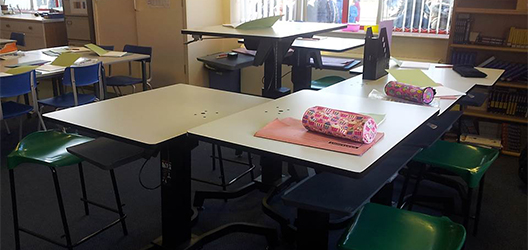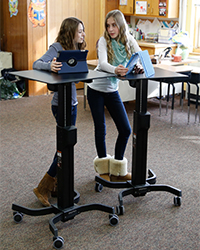
Loughborough study reveals standing desks in schools could help tackle sedentary behaviour

An example of the Ergotron LearnFit™ Adjustable Standing Desk used in the Melbourne study. Image: ©2015 Ergotron, Inc.
How best to combat sedentary behaviour (prolonged sitting) in primary schools and encourage children to become more active has formed the basis of two new pilot studies in the UK and Australia.
Led by researchers at Loughborough University, in partnership with the Bradford Institute for Health Research (BIHR), the Stand Out in Class study introduced a bank of six specialist Ergotron sit-to-stand desks in Year 5 classrooms (ages 9-10) in Bradford – a city with high levels of deprivation and childhood morbidity. Findings of this study were compared to a similar study conducted in Melbourne, Australia, where all standard desks in Year 6 classrooms (ages 11-12) were replaced with sit-to-stand desks.
Lifestyle health-related behaviours in childhood typically track into adulthood. But by changing environments associated with prolonged periods of sitting, such as the classroom, researchers believe sit-to-stand desks have the potential to change behaviour in younger generations.
The Stand Out in Class findings showed that it may not be necessary to replace all standard desks with sit-to-stand desks. For example, in the Bradford study, over a nine-week period, 27 pupils were exposed to the sit-to-stand desks once a day for at least one hour, resulting in a reduction in their classroom sitting time of 52 minutes a day on average. The pupils’ step count also increased significantly.
In comparison, in the Melbourne study, over a 10-week period, 26 pupils were exposed to sit-to-stand desks for the entire duration, and were initially encouraged to stand for at least one 30-minute class per day and to increase this gradually over the weeks. As a result, the pupils’ classroom sitting time reduced by 44 minutes a day, but there was no change recorded in their step count.
These findings could be attributed to the fact that the Bradford children had to move around the classroom more in order to use the six specialist desks. This desk rotation exercise appears to encourage more movement in class and suggests that by introducing a limited number of sit-to-stand desks in the classroom, this could help increase children’s in-class activity levels.
Previous studies have shown[1] that children in developed countries spend more than 65% of their waking hours sedentary (or sitting). This is a worrying trend which has been linked to a wide range of health problems including obesity, cardiovascular disease, some cancers and Type 2 diabetes.
Lead researcher Dr Stacy Clemes from Loughborough’s School of Sport, Exercise and Health Sciences (SSEHS), said: “Sitting down for prolonged periods is bad for your health, but in the classroom and the workplace this has become the norm.
“Our studies show that both sets of pupils spent a high proportion of their day sitting, which was particularly evident in the Bradford sample, where pupils sat for just under 10 hours a day, which is equivalent to 70% of their total waking hours.
“An urgent cultural shift is needed, and we feel that the only way to do this is to target the next generation of workers, particularly while they are still at school. If we can bring about a behaviour change, which we learn from a young age, then this will hopefully continue into adulthood and improve people’s overall quality of health.”
Pete Segar, CEO of Ergotron, the United States-based company responsible for donating the sit-to-stand desks used in this study, said: “The most important actions to address the global childhood obesity epidemic are improving diet and increasing activity with methods practical for a school to adopt.
“While standing may seem like a simple act when compared to larger global health and fitness initiatives, the reality – and what we believe is key here – is that standing desks designed so students can fluidly adjust to a height ideal for their bodies, like the ones used in this study, are a vehicle for increasing regular, low-impact physical activity.
“The desks allow students to move more, in turn increasing blood circulation, heart rate, calorie expenditure, even helping maintain muscle tone and insulin effectiveness. It’s also very encouraging that additional studies have shown improvements in student behaviour, engagement and academic performance.”
The Stand Out in Class study has been published in the Journal of Public Health and is available to view here.
The Bradford collaborators on this project are funded by the National Institute for Health Research (NIHR).